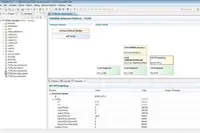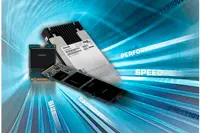Electronics News
Archive : 14 August 2015 год
 Altium has unveiled a free embedded software development toolset for semiconductor manufacturer Infineon’s TriCore/AURIX product line as part of their ongoing strategic partnership.
Altium has unveiled a free embedded software development toolset for semiconductor manufacturer Infineon’s TriCore/AURIX product line as part of their ongoing strategic partnership.
The toolset has been developed as part of a significant update to the TASKING compiler for TriCore/AURIX, and adds a number of new features and enhancements for advanced automotive application development.
The Lite Edition of the TASKING VX-toolset for TriCore includes a one year license and can be requested now on the Infineon or TASKING websites
"We were often asked about the availability of a quick and easy way to explore the advantages of TASKING compiler technology for Infineon AURIX microcontrollers," said Harm-Andre, TASKING Product Manager. "Our partnership with Infineon has allowed us to develop a free toolset that provides the embedded software developers around the world with the complete TASKING TriCore compiler experience with no compromises to features and performance."
Engineers can use the toolset to develop automotive applications that require high standards of safety, reliability and performance for the AURIX variants within the TriCore microprocessor family.
The move enables embedded software developers to explore the TASKING compiler technology with access to the major features included in the full toolset. The AURIX Configuration Tools (ACT) includes: Integrated Pin Mapper; Real-Time Operating System (RTOS) for TriCore and a Software Platform Builder.
Author
Neil Tyler
Source: www.newelectronics.co.uk
 Highway England, the UK government's roads agency, has announced that motorists will be able to recharge their cars as they drive, if a scheme currently under consideration comes to fruition.
Highway England, the UK government's roads agency, has announced that motorists will be able to recharge their cars as they drive, if a scheme currently under consideration comes to fruition.
According to a BBC report the agency plans to test wireless power-transfer technology that could be built under the UK's motorway and road network and has completed a feasibility study. The agency is now asking companies to tender bids to host off-road trials.
The process, which has already been deployed in South Korea, uses a process called Shaped Magnetic Field In Resonance.
The power-transfer technology works by using electric cables buried under the road to generate electromagnetic fields. These are then picked up by a coil inside the device and converted into electricity.
A limited scheme, which involves buses being wirelessly recharged via plates installed into roads, was deployed in Milton Keynes last year, although with this system vehicles are obliged to stop to recharge.
Speaking to the BBC a spokesman for the agency said, "What has been committed to is that by 2016 or 2017 we will hold off-road trials - in other words not on a public road. Where exactly the trials will be has yet to be determined."
Full details will be publicised once a contractor has been appointed and experiments will be run for about 18 months before any decisions are made to run on-road trials.
Doubts have been raised about the cost of the proposed scheme according to the article, which highlights the improvements in battery technology which may, in themselves, make this scheme redundant.
Author
Neil Tyler
Source: www.newelectronics.co.uk
 Toshiba Electronics Europe has unveiled three new families of solid state drives (SSDs) fitted with high-speed PCIe (Peripheral Component Interconnect Express) interfaces that provide high-bandwidth point-to-point links with the processor and reduce system bottlenecks.
Toshiba Electronics Europe has unveiled three new families of solid state drives (SSDs) fitted with high-speed PCIe (Peripheral Component Interconnect Express) interfaces that provide high-bandwidth point-to-point links with the processor and reduce system bottlenecks.
The drives use the NVMe (Non-Volatile Memory Express) protocol and have been designed for various applications including high performance notebooks, thin notebooks, 2-in-1/convertible notebooks, all-in-one PCs and tablets; and server and storage applications.
All three SSD families make use of Toshiba-developed controller platforms and Toshiba's own state-of-the-art MLC NAND flash memory.
The XG3 family of SSDs is housed in M.2 Type 2280 form factor and has been designed for high performance notebooks, 2-in-1 laptop and all-in-one PCs. The drives support up to four lanes of PCIe 3.1, which has a maximum interface bandwidth more than six times that of SATA 6.0 Gbits/s. The XG3 is the first NVMe SSD available in a 2.5-inch SATA express form factor and is equipped with Toshiba's QSBC (Quadruple Swing-By Code) error-correction technology, a highly efficient error correction code (ECC), which helps protect customer data from corruption, improves reliability, and extends the life of Toshiba SSDs. The XG3 series also features lower power state modes and is the first Toshiba product, along with the BG1 SSD family, to support the Trusted Computing Group security specification, Pyrite (TCG Pyrite).
The BG1 SSD family is available in a single package measuring just 16mm x 20mm (M.2 Type 1620) or a removable M.2 Type 2230 module with up to 256GB in capacity. Designed for thin notebooks, 2-in-1/convertible notebooks and tablets, the BG1 family enables PC OEMs to produce thin mobile PCs and tablets while offering a better performing alternative over SATA SSDs for mobile PCs. The BG1 SSD family supports TCG Pyrite and features lower power state modes.
The PX04P series of enterprise SSDs have been designed for servers and storage appliances needing scalable power and performance settings. The PX04P series NVMe uses only 18 Watts to power the drive at maximum performance. The family also supports up to four lanes of PCIe 3.0, and is available in either a HHHL (half-height half-length) add-in card or a 2.5-inch form factor with SFF-8639 connector. The eSSD family is also equipped with Toshiba's QSBC error-correction technology.
Author
Neil Tyler
Source: www.newelectronics.co.uk
 Conrad Business Supplies has introduced a new range of flexible and customisable programmable logic controllers (PLCs) exclusively from CONTROLLINO, a subsidiary of Austrian manufacturer SG-Tronic GmbH. These new products are suited to a variety of automation applications, including temperature management, advanced lighting and media control.
Conrad Business Supplies has introduced a new range of flexible and customisable programmable logic controllers (PLCs) exclusively from CONTROLLINO, a subsidiary of Austrian manufacturer SG-Tronic GmbH. These new products are suited to a variety of automation applications, including temperature management, advanced lighting and media control.
The range comprises of three models: the Mini, Maxi and Mega, each of which is aimed at meeting different levels of application requirement and complexity. All models, developed and implemented using the ARDUINO open source platform, are based on the ATmega microcontroller from Atmel and have a clock speed of 16MHz. Key features include a direct processor contact with 4000V ESD protection across all pins, a range of interfaces including SPI, I2C, RS232, RS485, and an internal real-time clock (RTC) which can be switched on and off. A front-panel USB port supports simplified external programming.
The CONTROLLINO Mini offers a number of different inputs and outputs (6x relays outputs, 8x analogue/digital inputs and 8x digital outputs) in a compact package, measuring 94.5mm x 59.4mm x 36mm. The Maxi offers greater flexibility (10x relays outputs, 12x analog/digital inputs and 12x digital outputs) with the addition of an Ethernet connecter and a second RS232 Interface.
The highest specification unit is the CONTROLLINO Mega, which is a capable of handling a current of up to 30A and offers 16x relays outputs, 24x analog/digital inputs, 12x high side switch digital outputs and a further twelve half-bridge digital outputs.
Author
Neil Tyler
Source: www.newelectronics.co.uk

